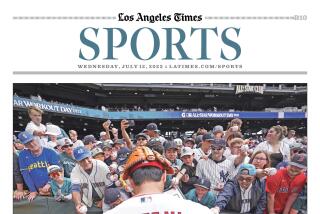Retailer Bouncing Back from Loss : Clothestime Woos ‘Older’ Women--and It Pays
- Share via
A simple strategy of changing its clothes--and going gung-ho for the “older” woman over 25--seems to be paying off for Clothestime Inc.
Second-quarter earnings released Wednesday show that the Anaheim-based retailer is bouncing back from a $2.2-million loss in fiscal 1988 after outfitting itself with more brand-name merchandise, more advertising, revamped stores and, of course, higher prices.
Clothestime’s net income for the quarter ended July 29 was $2.3 million, compared to $31,000 for the same period last year. Sales for the second quarter of fiscal 1989 jumped 20% to $52 million from $43.3 million a year ago.
On Wednesday, Norman Abramson, Clothestime’s president and chief operating officer, said it’s all a matter of selling what the customer wants. For Clothestime, that has meant moving away from an emphasis on the discount “junior” market, where the company found its early success.
Until recently, Clothestime catered to teen-age girls and young women from 14 to 24 years old. The strategy had worked well--profits increased steadily for six years. But in mid-1987 Clothestime began losing money as the women’s apparel industry in general went into a slide.
So last summer, Clothestime--which operates 330 stores in 15 states--broadened its customer base by adding career-oriented merchandise aimed at less-fickle shoppers: women up to 35 years old.
“They realized that younger women had limited amounts of money to spend and limited access to credit cards,” said Jeff Kilpatrick, president of Newport Securities of Costa Mesa. So “rather than selling sun dresses, shorts, and cotton blouses, they’re selling merchandise Nordstrom might sell, but at much-reduced prices.”
That meant moving away from off-price apparel to more nationally known labels like Judy Knapp, Bongo and LaBelle. Now, private labels are down to 10% of Clothestime’s inventory, with national brands up to about 85%, Abramson said.
At the same time, prices are up about 40% from last fall to a range Abramson describes as “pretty moderate.”
The retailer’s stores and displays underwent a transformation, too. Instead of endless racks of unmatched shorts, slacks and blouses, Clothestime customers now walk into better-organized stores with themed sections showing casual wear or career clothes, for instance, all displayed with coordinated pieces.
To tell customers about the changes, Clothestime also moved away from promoting its merchandise through flyers and mailing lists purchased from teen magazines. Instead, the chain is relying on an aggressive television and radio campaign that touts fashion and value over bargain-basement prices.
The changes have brought in about twice as many shoppers who use credit cards, boosting credit card sales to about 20% of Clothestime’s total purchases, Abramson said. Meanwhile, the average sale has climbed to about $37 from roughly $24 one year ago. “People are buying coordinated tops and bottoms, and prices are higher,” Abramson explained.
It also hasn’t hurt that the entire women’s retail apparel market--particular the junior market--is starting to come back.
For the first six months of fiscal 1989, Clothestime recorded net profits of $2.4 million, in contrast to a net operating loss of $783,000 a year earlier. The retailer reported a slim profit of $82,000 for its fiscal 1989 first quarter, contrasted with a loss of $819,000 in the year-earlier period.
The six-month numbers are even better than they look. During the first six months of last year, Clothestime actually suffered an operating loss of $1,451,000, which was reduced after an accounting change for tax purposes.
Sales, meanwhile, climbed to $93.2 million for the first six months of fiscal 1989--a 15% jump from $81.1 million for the first half of last year.
Even though Clothestime’s expansion plans have slowed, Abramson still foresees 1,000 outlets by 1994 or 1995. “We can add 120 additional stores in existing markets” of Southern California, Texas, Miami and Chicago through 1990, he said.
After that, Abramson said, “the East Coast--from Washington to Boston--is an attractive market. . . . We’re back on an expansion kick.”
CLOTHESTIME RESULTS
Revenue Net income (millions) (thousands) Fiscal 1987 First quarter $40.8 $2,556 Second quarter 49.4 5,215 Third quarter 46.7 -1,565 Fourth quarter 41.6 303 1988 First quarter 37.7 -819 Second quarter 43.3 31 Third quarter 44.6 633 Fourth quarter 45.7 -2,008 1989 First quarter 41.2 82 Second quarter 52.0 2,300
More to Read
Inside the business of entertainment
The Wide Shot brings you news, analysis and insights on everything from streaming wars to production — and what it all means for the future.
You may occasionally receive promotional content from the Los Angeles Times.










